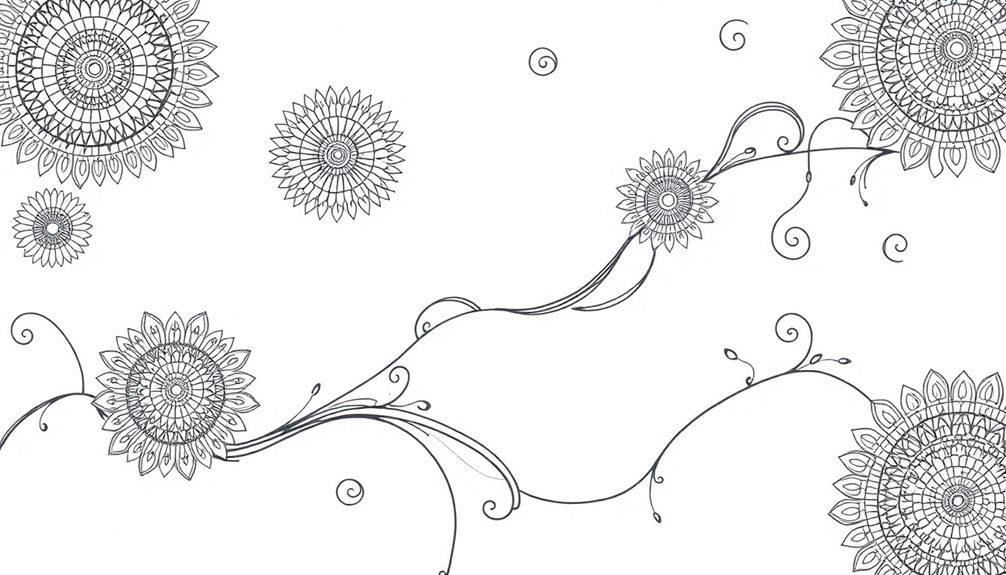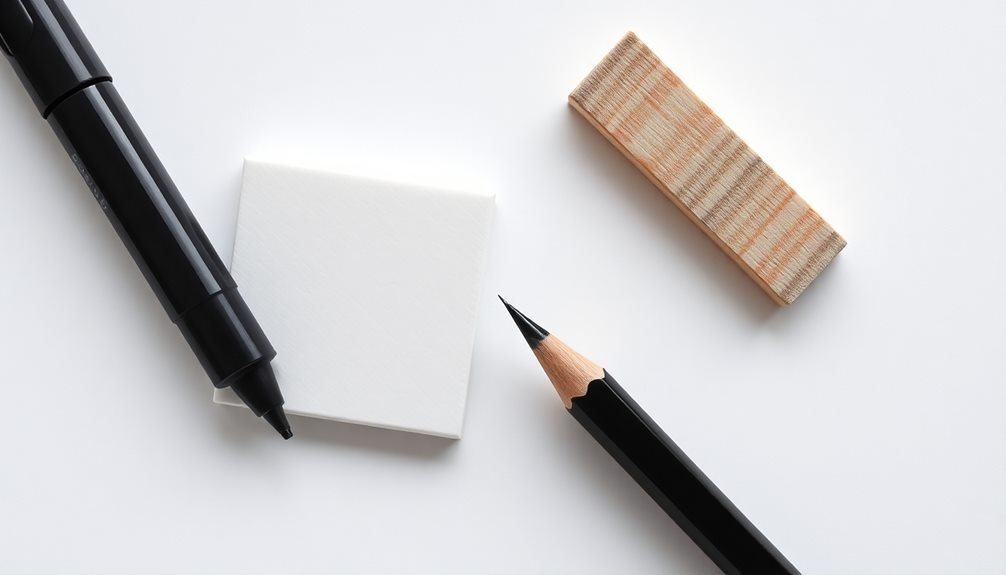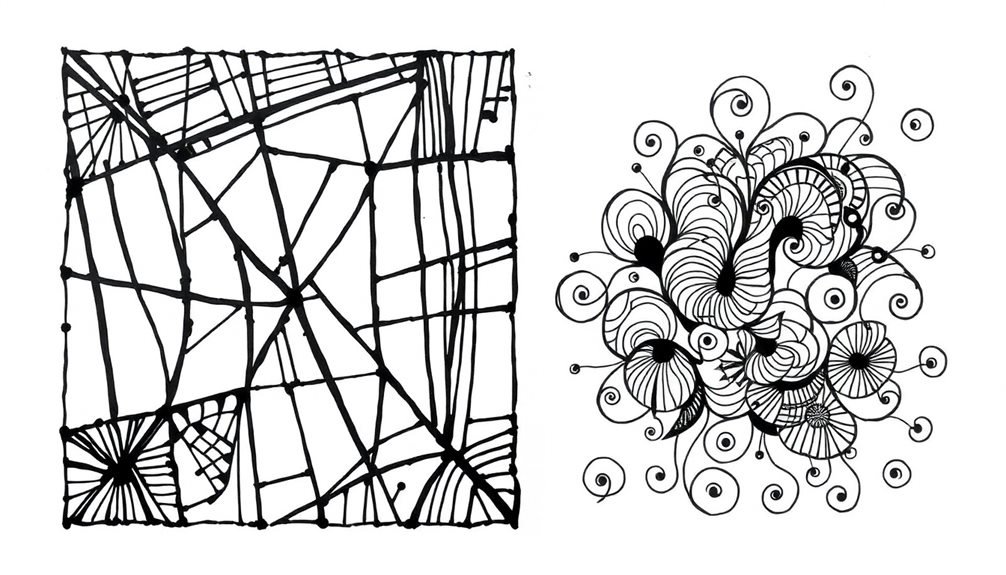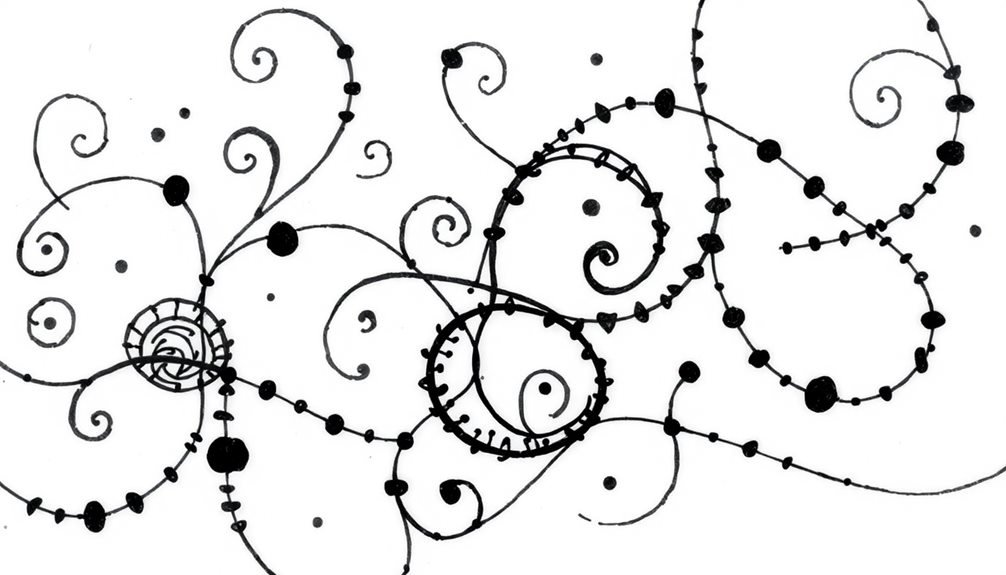Zentangle patterns quiet your anxious mind by engaging your brain in a unique form of mindful meditation through art. When you draw these structured patterns, you activate your prefrontal cortex while calming your default mode network – the same effect achieved through traditional meditation. The repetitive, focused drawing releases dopamine and reduces cortisol, your body's stress hormone. You'll find your racing thoughts slow down as you concentrate on creating one line at a time. Just 15 minutes of daily practice can rewire your neural pathways for better stress management. Discover how these simple patterns can transform your mental well-being.
Understanding the Zentangle Method

What makes the Zentangle Method so effective for anxiety relief? This mindful art form combines structured patterns with freehand drawing to create beautiful abstract designs while calming your mind. You'll find that it's different from typical doodling because it follows a deliberate, step-by-step process that encourages focus and presence.
When you practice Zentangle, you'll work on small square papers called "tiles," using simple tools like fine-tipped pens and pencils. The method breaks down complex patterns into basic strokes that anyone can learn, regardless of artistic ability.
You'll start by drawing boundary lines to create sections, then fill each space with repetitive patterns called "tangles."
The key principles include working without an eraser, having no up or down orientation, and approaching each stroke with intention. You don't plan the outcome; instead, you focus on one line at a time, letting the pattern evolve naturally.
This process shifts your attention away from anxious thoughts, activating the relaxation response in your brain. The method's structured yet creative nature provides a perfect balance of guidance and artistic freedom, making it an effective tool for anxiety management.
The Science Behind Mindful Drawing
The calming effects of Zentangle aren't just anecdotal – scientific research supports the powerful impact of mindful drawing on the brain. When you engage in repetitive pattern creation, your brain shifts into a state similar to meditation, triggering the relaxation response and lowering cortisol levels. You'll notice your heart rate slowing and your breathing becoming more regulated as you focus on each stroke.
Neuroscience has revealed several ways mindful drawing affects your brain:
- It activates the default mode network (DMN), the same region engaged during meditation and deep relaxation.
- Your prefrontal cortex becomes more active, enhancing focus and reducing anxiety-producing thoughts.
- The repetitive motions stimulate the release of dopamine, your brain's natural feel-good chemical.
- The bilateral movement involved in drawing engages both brain hemispheres, promoting neural integration.
When you practice Zentangle regularly, you're actually rewiring your neural pathways to better handle stress. The structured nature of the patterns provides a sense of control, while the artistic process allows your mind to enter a flow state that interrupts anxiety cycles.
Benefits for Mental Health

Many mental health professionals recognize Zentangle as a powerful therapeutic tool for managing anxiety, depression, and stress-related conditions. When you practice Zentangle, you'll experience a natural reduction in cortisol levels, your body's primary stress hormone. This meditative drawing practice helps activate your parasympathetic nervous system, shifting you into a calmer, more relaxed state.
You'll find that Zentangle's structured patterns provide a sense of control and predictability, which can be especially soothing when you're feeling overwhelmed. The repetitive nature of creating these patterns helps quiet racing thoughts and brings your focus to the present moment. It's particularly effective because you don't need artistic skill to benefit from the practice.
The process also boosts your self-esteem as you complete each pattern, triggering the release of dopamine – your brain's reward chemical. You'll discover that regular Zentangle practice can improve your concentration, enhance problem-solving abilities, and develop greater emotional resilience.
Many practitioners report better sleep quality and reduced anxiety symptoms after incorporating just 15 minutes of daily Zentangle into their routine.
Getting Started With Basic Patterns
Starting your Zentangle journey begins with mastering simple shapes like circles, lines, and curves – you'll find these basic elements form the foundation for more complex patterns.
You'll need just a few essential tools: a fine-tipped pen, high-quality paper, and a pencil for light guidelines.
Focus first on practicing core patterns like "Crescent Moon," "Static," and "Rice" until you can draw them confidently and smoothly.
Simple Shapes Come First
Basic Zentangle patterns begin with fundamental shapes you already know – circles, squares, lines, and dots. These simple elements form the building blocks of more complex designs, allowing you to create intricate patterns while maintaining a sense of control and familiarity.
When you're feeling anxious, starting with these basic shapes helps your mind focus on manageable, predictable components.
Start by practicing these foundational elements:
- Draw a series of evenly spaced straight lines, both horizontal and vertical, to create a grid-like structure that serves as your pattern's framework.
- Add circles of varying sizes, overlapping them to create interesting intersections and depth within your design.
- Incorporate simple squares, positioning them at different angles to add visual interest and movement to your pattern.
- Place dots strategically throughout your work to fill spaces and create texture.
As you become comfortable with these basic shapes, you'll naturally begin combining them in different ways.
Your confidence will grow as you discover how these simple elements can transform into complex, beautiful patterns that help quiet your anxious thoughts.
Tools You'll Need
Simplicity is key when gathering supplies for Zentangle patterns. You'll need just a few essential items to begin your journey: a smooth paper tile (3.5" x 3.5"), a fine-tipped black pen (like a Micron 01 or 05), and a regular pencil with an eraser.
The paper tile's size keeps your work manageable and less overwhelming, while the pen's precision helps create clean, defined lines. For traditional Zentangle practice, stick to black ink on white paper. This high-contrast combination allows you to focus on pattern creation without the distraction of color.
Your pencil will serve two purposes: creating a light framework of guidelines and adding shading to give your patterns depth. Optional but helpful tools include a tortillon (paper blending stump) for smoothing graphite shading, and a ruler for creating straight edges when needed.
You might also want a sketchbook for practice and pattern exploration. Don't worry about fancy art supplies – the beauty of Zentangle lies in its accessibility and the meditative process, not expensive materials.
Practice These Core Patterns
Zentangle's foundational patterns provide a perfect entry point for beginners to build confidence and skill.
These basic designs create a strong foundation for your mindfulness practice while keeping your anxiety at bay. You'll want to master these core patterns before moving on to more complex designs.
- Crescent Moon: Start with a series of curved lines that resemble half-moons. Space them evenly, and fill each crescent with simple shading to create depth. This pattern helps develop steady hand control.
- Static: Draw short, straight lines in various directions, keeping them close together. This pattern teaches you to maintain consistent spacing and line weight while letting go of perfectionism.
- Florz: Create a grid of evenly spaced dots, then connect them with straight lines to form squares. Add small circles in the centers to complete this classic pattern that builds concentration.
- Hollibaugh: Draw straight lines that cross over each other, then erase the sections where they intersect to create an under-over weaving effect. This pattern develops your understanding of depth and perspective.
Practice each pattern until you're comfortable with the basic movements and can draw them without hesitation.
Essential Tools and Materials

Getting started with Zentangle requires just a few essential materials that are both affordable and easy to find.
You'll need a high-quality black fineliner pen (like a Micron 01 or 05), white paper tiles (3.5" x 3.5" squares), and a regular graphite pencil for shading. While official Zentangle tiles are available, you can cut any smooth white paper into squares.
For enhanced shading effects, you'll want to add a tortillon or paper stump to your toolkit. This blending tool helps create smooth gradients and depth in your patterns. A good eraser is also helpful for removing initial pencil guidelines without damaging your paper.
Optional but useful additions include a ruler for creating straight edges, different pen sizes for varying line weights, and gray markers for additional shading techniques.
If you're just beginning, don't feel pressured to buy everything at once. Start with the basic trio – pen, pencil, and paper – and expand your collection as your skills develop.
Store your tools in a small case or pouch to keep them organized and protected when you're practicing on the go.
Creating Your Sacred Space
With your tools assembled and ready, it's time to establish a calming environment for your Zentangle practice. Choose a quiet corner of your home where you won't be disturbed for at least 15-30 minutes. This dedicated space should feel inviting and peaceful, allowing you to focus solely on your artistic meditation.
Creating your sacred space doesn't require elaborate decoration or expensive items. Instead, focus on these essential elements:
- Lighting – Position yourself near natural light when possible, or use soft, warm artificial lighting that won't cast harsh shadows on your work.
- Seating – Select a comfortable chair that supports good posture and allows your arms to rest naturally at the drawing surface.
- Surface – Choose a clean, stable table or desk at an appropriate height to prevent neck and shoulder strain.
- Ambiance – Consider adding calming elements like gentle background music, essential oils, or a small plant to enhance your mindful experience.
Keep your Zentangle supplies organized and within easy reach. You'll find that having a consistent, welcoming space makes it easier to maintain a regular practice and maximize the anxiety-reducing benefits of this meditative art form.
Popular Zentangle Patterns for Beginners

Starting with basic patterns like Crescent Moon and Hollibaugh will help you build confidence in your Zentangle practice.
You'll need simple tools: a pencil, fine-liner pen, paper, and tortillon for shading.
These foundational patterns use elementary strokes that you can master through step-by-step instructions, making them perfect for beginners who want to reduce anxiety through mindful drawing.
Basic Patterns and Steps
Zentangle's most foundational patterns provide a perfect entry point for beginners seeking stress relief through artistic meditation. You'll start with simple strokes that form the basis of more complex designs, allowing your mind to focus solely on each mark you make. These elementary patterns don't require artistic skill, just your attention to the present moment.
When you're ready to begin, grab a pencil, pen, and paper tile. Each pattern builds upon basic shapes and lines that you'll combine in different ways to create mesmerizing effects. The repetitive nature of these patterns helps quiet racing thoughts and reduce anxiety.
- Crescent Moon – Draw a series of curved lines that nest within each other
- Static – Create short, straight lines that intersect randomly across your tile
- Hollibaugh – Make straight lines that appear to weave over and under each other
- Rice – Draw small oval shapes clustered together in varying directions
Practice these patterns individually before combining them. You'll notice your confidence growing with each stroke, and you'll naturally develop a rhythm that promotes mindfulness and relaxation.
Tools to Get Started
After mastering basic patterns, you'll need the right tools to continue your Zentangle journey. A standard Zentangle kit includes a 3.5-inch square tile of high-quality paper, a graphite pencil (2H or HB), a fine-tip black pen (Micron 01 or similar), and a tortillon for shading.
The paper matters greatly – use acid-free, smooth bristol or cardstock that won't bleed when you apply ink. Your pen should be waterproof and archival-quality to prevent smudging. While traditional Zentangle uses black ink, you can experiment with colored fine-liners once you're comfortable with the basics.
Additional helpful tools include a ruler for creating string patterns, a white gel pen for highlights, and a pencil sharpener. Store your supplies in a portable case, allowing you to practice anywhere when anxiety strikes.
Don't feel pressured to buy everything at once – start with the essentials (pen, pencil, and paper) and expand your collection as needed.
Breathing Techniques While Drawing
During your Zentangle practice, proper breathing helps maintain focus and reduce anxiety. You'll find that synchronized breathing with your drawing movements creates a natural rhythm that calms your mind and steadies your hand. As you draw each pattern, breathe deeply from your diaphragm rather than taking shallow chest breaths.
To maximize the calming benefits of breathing while creating Zentangle patterns:
- Start with a cleansing breath before you begin drawing – inhale for four counts, hold for two, then exhale for six counts.
- Match your breath to your strokes – draw on the exhale when you need steady lines, and use the inhale to pause and plan your next section.
- When you're feeling tense, slow your breathing to a 4-7-8 pattern (inhale for 4, hold for 7, exhale for 8) while continuing to draw.
- If you notice you're holding your breath while concentrating, consciously return to regular breathing by counting your inhales and exhales.
Remember that your breathing shouldn't feel forced. Let it flow naturally as you develop your own rhythm between breath and artistic movement.
You'll soon notice how this mindful breathing transforms your Zentangle practice into a more meditative experience.
Breaking Down Complex Patterns

Complex Zentangle patterns become manageable when you break them into smaller, basic shapes and steps. Rather than feeling overwhelmed by intricate designs, you'll find success by focusing on one element at a time. Start with basic geometric shapes like circles, squares, and triangles that form the foundation of most patterns.
| Basic Shape | Common Uses | Difficulty Level |
|---|---|---|
| Circle | Flowers, swirls | Easy |
| Square | Grids, borders | Easy |
| Triangle | Stars, leaves | Medium |
| Line | Weaving, stems | Easy |
When tackling a new pattern, first identify its core components. You'll notice that even the most elaborate designs rely on simple repetitions of these basic shapes. Draw guidelines lightly to map out your pattern's structure, then build complexity gradually. If you're working on a flower pattern, start with the center circle, add petals one at a time, and finally incorporate details like shading or dots.
Don't rush through the process – breaking down patterns trains your mind to focus on the present moment, reducing anxiety as you work step by step.
Daily Practice for Anxiety Relief
A consistent daily Zentangle practice can markedly reduce anxiety levels over time. When you make Zentangle a part of your daily routine, you'll notice your mind becoming calmer and more focused during stressful situations.
Just 15-20 minutes of drawing patterns can shift your brain into a meditative state, releasing tension and worry.
To establish an effective daily Zentangle practice for anxiety relief:
- Set aside a specific time each day, preferably in the morning or when you typically feel most anxious, to create your patterns.
- Keep your Zentangle supplies organized and easily accessible in a dedicated space, removing barriers to getting started.
- Begin each session with three deep breaths and a moment to center yourself before putting pen to paper.
- Track your anxiety levels before and after each session in a simple journal to monitor your progress.
Don't pressure yourself to create perfect patterns. Instead, focus on the rhythmic, repetitive motions of drawing.
You'll find that the simple act of creating these structured designs helps quiet racing thoughts and brings your attention to the present moment.
Common Mistakes to Avoid

When you're starting your Zentangle practice, you'll likely find yourself rushing through the lines or aiming for perfect patterns right away.
These two common mistakes can increase your anxiety instead of reducing it, as rushing prevents mindful focus while perfectionism creates unnecessary pressure.
Remember that Zentangle is about the meditative process of drawing each line with intention, not about racing to finish or creating flawless artwork.
Drawing Lines Too Quickly
Many beginner tanglers rush through their line-drawing, which undermines the meditative benefits of Zentangle. When you draw lines too quickly, you'll likely experience shaky, uneven strokes and miss the calming effect that comes from mindful, deliberate movement.
Remember, Zentangle isn't about reaching the finish line—it's about being present in each moment and each stroke.
To avoid rushing through your line work, follow these essential guidelines:
- Take slow, measured breaths as you draw each line—sync your breathing with your pen strokes to maintain a steady rhythm.
- Position your arm and wrist comfortably, allowing for fluid movement without tensing your muscles.
- Count to three or four for each line you draw, ensuring consistent speed and pressure throughout.
- Focus on the sensation of your pen touching the paper, noticing how it feels as you create each stroke.
You'll find that slowing down your line-drawing not only improves the visual quality of your patterns but also helps quiet your racing thoughts and reduces anxiety more effectively.
Seeking Instant Perfection
Related to rushing through lines is another common obstacle: the pursuit of perfection from the start. When you're learning Zentangle patterns, you might feel frustrated if your designs don't immediately match the polished examples you see online. This perfectionism can trigger anxiety rather than relieve it, defeating the practice's purpose.
Remember that Zentangle is about the journey, not the destination. Even experienced artists started with wobbly lines and uneven patterns. Instead of expecting masterpieces immediately, focus on small improvements with each stroke.
If you notice yourself becoming tense or critical, pause and take a deep breath. Acknowledge that imperfections aren't flaws – they're unique elements that make your work distinctly yours.
Try this approach: Draw your pattern slowly, accepting each line as it comes. Don't erase or restart – work with what you've created. You'll likely find that perceived "mistakes" often lead to unexpected and beautiful variations.
This mindset shift from seeking perfection to embracing the process will help you experience the true calming benefits of Zentangle practice.
Building Your Pattern Library
Several essential Zentangle patterns form the foundation of a strong practice, and building your personal pattern library starts with mastering these basics.
You'll want to begin with simple patterns like Crescent Moon, Hollibaugh, and Pearls before advancing to more complex designs. As you practice, you'll discover which patterns resonate most with your style and help calm your anxiety.
Start collecting patterns that speak to you by:
- Creating a dedicated sketchbook where you'll draw each pattern multiple times until it becomes muscle memory.
- Following official Zentangle resources and certified teachers on social media platforms for new pattern inspiration.
- Practicing one new pattern daily, incorporating it with patterns you've already mastered.
- Documenting your favorite combinations in a reference guide for future use.
Don't feel pressured to learn every pattern you encounter. Instead, focus on building a core collection of 12-15 patterns you can draw confidently.
You'll find that having these reliable patterns at your fingertips makes it easier to begin tangling whenever anxiety strikes, allowing you to enter a meditative state more quickly.
Combining Patterns for Stress Relief

The art of combining Zentangle patterns creates a soothing flow that enhances the stress-relieving benefits of your practice. When you blend different patterns, you'll discover unique ways to shift between designs while maintaining a meditative state.
Start by selecting two to three patterns you've mastered and experiment with connecting them organically. Focus on creating smooth shifts between patterns by letting one design naturally flow into the next. You can use curved lines, dots, or shared borders as connection points.
As you work, don't worry about perfection – allow your mind to focus on the rhythmic process rather than the end result. Try combining angular patterns with flowing ones to create dynamic contrast. You'll find that certain combinations help you maintain focus better than others.
When anxiety strikes, pair structured patterns like "Paradox" with fluid designs like "Mooka" to help ground your thoughts. Keep a journal of pattern combinations that work best for calming your mind, and return to these trusted pairings when you need quick stress relief.
Remember that the goal isn't to create complex artwork but to maintain a peaceful, focused state of mind.
Frequently Asked Questions
Can Zentangle Patterns Be Incorporated Into Tattoo Designs?
You can definitely incorporate Zentangle patterns into tattoo designs. They'll create unique, intricate artwork that flows naturally on your skin. Many tattoo artists already use these detailed, repetitive patterns in their custom designs.
Do Zentangle Artists Make Money Selling Their Artwork?
You can earn money selling your Zentangle art through various channels. You'll find opportunities on Etsy, art fairs, galleries, and by teaching workshops. Many artists also sell prints and take custom commissions.
Are There Zentangle Competitions or Exhibitions Worldwide?
You'll find multiple Zentangle exhibitions and competitions worldwide. You can join events like the Zentangle Academy Mosaic App challenges, CZT gatherings, and art shows. Many local galleries also feature Zentangle artwork regularly.
How Does Zentangle Differ From Traditional Mandala Drawing?
You'll find Zentangle uses free-form, structured patterns in square tiles, while mandalas are circular designs radiating from a center point. Zentangle doesn't require symmetry or planning, but mandalas traditionally follow strict geometric principles.
Can Children With ADHD Benefit From Practicing Zentangle Art?
You'll find zentangle art can help your child with ADHD improve focus and reduce restlessness. It's a structured yet creative activity that lets them practice mindfulness while drawing, making concentration feel more natural.
In Summary
You'll find that zentangle patterns offer a powerful way to calm your anxious thoughts through mindful creativity. Start small, experiment with different patterns, and don't worry about perfection. As you build your pattern library and practice regularly, you're training your brain to focus on the present moment. Whether you're a beginner or an experienced artist, zentangling can become your daily ritual for finding peace and mental clarity.





Leave a Reply